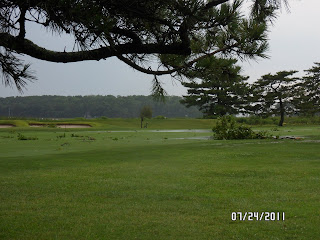Sunday, July 24, 2011
Thursday, July 21, 2011
Managing Greens in Hot, Humid Weather
The picture above shows turf thinning on #15 green Seaside. This is not uncommon in traffic areas on greens during very hot, humid weather. The soil based greens on Seaside are MORE susceptible to thinning. Things we do to help the greens survive are: we aerified the greens BEFORE this weather event with 1/4" solid tines to release carbon dioxide from the root zones and let fresh oxygen into the soil. We read a USGA recommendation and raised mowing height by .005 inch. We also will use solid rollers on the greens mowers. The rollers we use most of the year are grooved. The grooves stand the grass up allowing for a cleaner cut. The grooved rollers put a lot of mechanical stress on the greens. Until the weather cools for the summer, we have put smooth 19 pound rollers on the Seaside greens mowers. We have to give the soil greens every advantage to survive the harsh conditions. We take a long term approach to management. It is easy to maintain the same way during stressful weather. We are trying to be proactive. Smoothness will not suffer, but the speeds won't be what everyone would like. In addition, the bentgrass and poa annua "puffs up" during extreme heat as a defense mechanism. If the height was to be maintained at the original level, the greens would scalp and be severely damaged. We have to be very careful with our chemical and fertilizer selections. So now you have a little glimse of what we face when maintaining your playing conditions. We also try to see problems before they become problems.
Monday, July 18, 2011
Newport Fairways Update
I think we all can agree the fairways on Newport Bay are dramatically improved. In addition to the increased granular fertilizer applications, we have been spraying feed grade urea weekly. With the lower mowing heights and increase in fertilizer, we are encouraging bermudagrass growth. Most of the larger areas we sprayed with Revolver (killing the poa annua and ryegrass) are filling in. We are in the process of plugging and sand topdressing the weakest areas. The above picture shows bermudagrass filling in a spot previously occupied with poa annua. Remember the only fairways we did NOT spray are 18, 17, 13, 11, 8 and the right of 5. Some of these areas will likely be sprigged in the worst areas next year. Our goal is to have some of the finest bermudagrass fairways in the area within the next 2-3 years.
Sunday, July 17, 2011
Why So Much Green Dye?
We use two types of green dye when spraying greens. On the right is TRACKER. We use 16 oz per acre. Tracker indicates where we have sprayed and avoids costly overlaps and misapplications. We also can see if a spray nozzle is clogged. Tracker is a necessary evil. I'm sorry it does create some problems for early players when we spray. We try to spray with enough time for sufficent drying.
On the left is a product introduced a few years back, but was introduced last year as a stand alone product PAR. PAR is actually a stressguard for the greens. We use 16 oz per acre every two weeks. PAR is like spraying SPF 50 on the turf.
The dye is usually gone the next day through mowing or irrigation. The PAR once dry on the plant, lasts two weeks.
I hope this explaination is helpful.
On the left is a product introduced a few years back, but was introduced last year as a stand alone product PAR. PAR is actually a stressguard for the greens. We use 16 oz per acre every two weeks. PAR is like spraying SPF 50 on the turf.
The dye is usually gone the next day through mowing or irrigation. The PAR once dry on the plant, lasts two weeks.
I hope this explaination is helpful.
Subscribe to:
Comments (Atom)































